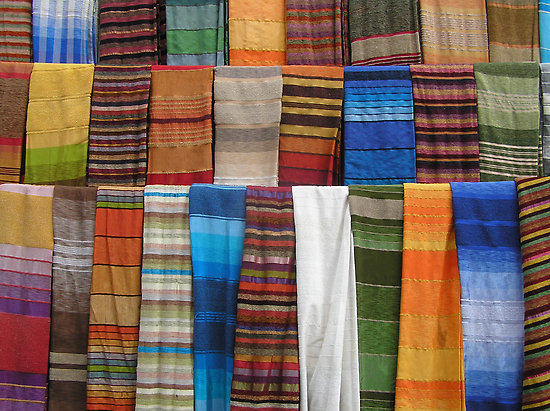
For textile aficionados, there are not many places as rewarding as Morocco in the world. The country has a long tradition of welcoming not only travelers interested in this craft, but also the best reputed textile and fashion designers, who come over to draw inspiration from the work and expertise of the local master weavers, especially in Fes – one of the few places worldwide where the drawloom, a traditional weaving artifact which disappeared in the Western world in the early 19th century as a result of mechanization, is still being used. Add to this the Moroccan taste for extricate patterns, and the incredible variety of styles that the country displays – no wonder that fashion designers such as Yves Saint Laurent turned Morocco into their second home!
As more and more men and – to a lesser extent – women adopted Western clothing in Morocco, and synthetic fabrics – which wash better and are more resistant – started to replace traditional ones, the viability of hand woven textiles in Morocco became under threat, a situation made the more alarming by the lack of young apprentices. Irresponsible tourism had its share of blame in this as well; whilst Moroccans know and appreciate the skills, time, and expertise involved in the hand weaving of clothing, and are ready to pay, if able, fabulous amounts for a finely made piece, tourists, who are generally unaware of the implications, created a trend to lower the prices, causing traditional weavers to abandon the centenary secrets of their trade, and resort to machines and low quality fabrics in order to survive. By the end of the 80’s of 20th century, only two traditional drawlooms were still in use in Fes. Ever since, there has been a revival of the interest towards traditional techniques, and a new generation of young artists and designers has become fascinated by these, and are using them for their creations. The situation thus is not as bad as it used to be but nevertheless, and specially with regards to the drawloom, the survival of tradition is far from being safe.
We are talking of techniques, patterns and styles that can be traced back to the Moorish of Al Andalous, who seek refuge in Fez after being expelled from Spain by the Christians, in 1492, bringing with them the secrets of their trades, and that have changed very little over the course of the centuries. When travel writers talk about Fes being still largely medieval they are not just being rhetorical, or referring to its architectural jewels, only.
Some of the best weavers’ workshops in Fes and Marrakech are happy to open their doors to Montain Voyage’s travelers interested in their craft. You’ll have the chance to interact with the artisans and share with them their hopes, and the challenges their lives and trade are facing. You’ll witness the use of the drawloom, and the vertical and horizontal looms, learning their basics. Embroidery and passementerie, a trim still widely used in Morocco, will be explained to you.
For textile and fashion professionals, we can arrange a comprehensive tour around the country, with visits to the best reputed artisans and shops in every place, and without neglecting the exciting new scene of young and talented Moroccan designers and artists that grows in the big cities, specially Casablanca, Fes and Marrakech. Inspiration is guaranteed! Get in touch to know more…
